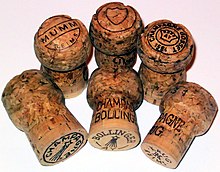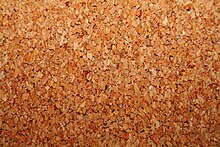Cork (material): Difference between revisions
Tag: possible conflict of interest |
|||
| Line 80: | Line 80: | ||
* Henley, Paul, ''BBC.com'' (September 18, 2008). [http://news.bbc.co.uk/2/hi/europe/7623912.stm "Urging vintners to put a cork in it"]. |
* Henley, Paul, ''BBC.com'' (September 18, 2008). [http://news.bbc.co.uk/2/hi/europe/7623912.stm "Urging vintners to put a cork in it"]. |
||
* [[PricewaterhouseCoopers]]/ECOBILAN (October 2008). [http://www.corkfacts.com/pdffiles/Amorim_LCA_Final_Report.pdf Analysis of the life cycle of Cork, Aluminium and Plastic Wine Closures] |
* [[PricewaterhouseCoopers]]/ECOBILAN (October 2008). [http://www.corkfacts.com/pdffiles/Amorim_LCA_Final_Report.pdf Analysis of the life cycle of Cork, Aluminium and Plastic Wine Closures] |
||
* APCOR: Yearbook (2009).[http://apcor.pt/userfiles/File/Publicacoes/AnuarioAPCOR2009.pdf] |
|||
==External links== |
==External links== |
||
Revision as of 16:54, 28 January 2010
Cork material is an impermeable, buoyant material, a prime-subset of generic cork tissue that is harvested for commercial use primarily from Quercus suber (cork oak) that is endemic to southwest Europe and northwest Africa. Cork is composed of suberin, a hydrophobic substance, and because of its impermeability, buoyancy, elasticity, and fire resistance, it is used in a variety of products, the most common of which is for wine stoppers. Portugal produces approximately 50% of cork harvested annually worldwide.[1]
Sources and harvesting
There are about 2,200,000 hectares of cork forest worldwide; 33% in Portugal, and 23% in Spain. Annual production is about 340,000 tons; 52% from Portugal, 32% from Spain, 6% Italy.
Once the trees are about 25 years old the cork is stripped from the trunks every nine years. The trees live for about 200 years. The first two harvests produce cork which does not yet have the appropriate thickness to be used as a cork stopper, and is therefore used for other other products. Only from the third harvest onwards can the cork be used for the wine industry.
The cork industry is generally regarded as environmentally friendly.[2] The sustainability of production and the easy recycling of cork products and by-products are two of its most distinctive aspects. Cork oak forests also prevent desertification and are the home of various endangered species.[3]
Carbon footprint studies committed by Corticeira Amorim, Oeneo Bouchage of France and the Cork Supply Group of Portugal concluded that cork is the most environmentally friendly wine stopper, in comparison to other alternatives. The Corticeira Amorim’s study, in particular ("Analysis of the life cycle of Cork, Aluminum and Plastic Wine Closures"), was developed by PricewaterhouseCoopers, according to ISO 14040 and ISO 14044 standards.[4] Results concluded that, concerning the emission of greenhouse gases, each plastic stopper released 10 times more CO2, whilst aluminium releases 26 times more CO2, to that of a cork stopper. Furthermore, and in addition to producing oxygen through photosynthesis, the unique call structure of the cork oak traps CO2 which contributes to global warming. According to a study published by the School of Agronomy - Technical University of Lisbon, the Portuguese cork oak forests retain 4.8 million tonnes of CO2 annually. Consequently, one can conclude that the Mediterranean cork forests (with an area of 2.2 million hectares - three times that of Portugal, with 736 thousand hectares), may be able to retain over 14 million tonnes of CO2 annually.[5]
Cork oak forests comprise the majority of habitat for the Iberian lynx, one of the most endangered cat species in the world. Its decline has been a function of a loss of habitat due to development of housing as well as the introduction of a virus to control the rabbit population which was the lynx's primary prey.
Properties and uses
Cork's elasticity combined with its near-impermeability makes it suitable as a material for bottle stoppers, especially for wine bottles. Cork stoppers represent about 60% of all cork based production.
Cork's low density makes it a suitable material for fishing floats and buoys, as well as handles for fishing rods (as an alternative to neoprene).
Sheets of cork, often the by-product of more lucrative stopper production, are used to make floor tiles and bulletin boards.
Granules of cork can also be mixed into concrete. The composites made by mixing cork granules and cement have low thermal conductivity, low density and good energy absorption. Some of the property ranges of the composites are density (400–1500 kg/m³), compressive strength (1–26 MPa) and flexural strength (0.5–4.0 MPa).[6]
Use for wine bottle closures
As late as the mid-1600s, French vintners did not use cork stoppers, using oil-soaked rags stuffed into the necks of bottles instead.[7]
Wine corks can be made of either a single piece of cork, or composed of particles, as in champagne corks; corks made of granular particles are called "technical corks".
Natural cork closures are used for about 80% of the 20 billion bottles of wine produced each year.[citation needed] After a decline in use as wine-stoppers due to the increase in the use of cheaper synthetic alternatives, cork wine-stoppers are making a comeback and currently represent approximately 60% of wine-stoppers today.
Cork is a suitable material for use as a bottle stopper. Because of the cellular structure of cork, it is easily compressed upon insertion into a bottle and will expand to form a tight seal. The interior diameter of the neck of glass bottles tends to be inconsistent, making this ability to seal through variable contraction and expansion an important attribute. However, unavoidable natural flaws, channels, and cracks in the bark make the cork itself highly inconsistent. In a 2005 closure study 45% of corks showed gas leakage during pressure testing both from the sides of the cork as well as through the cork body itself.[8]
Since the mid-1990s, a number of wine brands have switched to alternative wine closures such as synthetic plastic stoppers, screwcaps, or other closures. In some countries, screwcaps are often seen as a cheap alternative destined only for the low grade wines, however in Australia, for example, the majority of non-sparkling wine production now uses these caps as a cork alternative. These alternatives to real cork have their own properties, some advantageous and others controversial. For example, while screwtops are generally considered to offer a trichloroanisole (TCA) free seal they reduce the oxygen transfer rate to almost zero, which can lead to reductive qualities in the wine. TCA is one of the primary causes of cork taint in wine. However, in recent years major cork producers (Amorim, Álvaro Coelho & Irmãos, Cork Supply Group, and Oeneo) have developed methods that remove most TCA from natural wine corks. Natural cork stoppers are important because they allow oxygen to interact with wine for proper aging, and are best suited for bold red wines purchased with the intent to age.
The study "Analysis of the life cycle of Cork, Aluminum and Plastic Wine Closures," commissioned by cork manufacturer Amorim and made public in December 2008, concluded that cork is the most environmentally responsible stopper, in a one-year life cycle analysis comparison with the plastic stoppers and aluminum screwcaps.[9]
Other uses
Cork is used in musical instruments, particularly woodwind instruments, where it is used to fasten together segments of the instrument, making the seams airtight. Conducting baton handles are also often made out of cork.
Cork can be used as bricks for the outer walls of houses, as in Portugal's pavilion at Expo 2000.
On November 28, 2007, the Portuguese national postal service CTT issued the world's first postage stamp made of cork.[10][11]
Cork is used as the core of a baseball. Replacing the interior of a baseball bat with cork—a practice known as corking—was historically a method of cheating at baseball; the efficacy of the practice is now discredited.
Miscellaneous
The Cork Oak is unrelated to the "cork trees" (Phellodendron), which have corky bark but are not used for cork production.
Cork was examined microscopically by Robert Hooke, who discovered and named the cell.
See also
- Alternative wine closures
- APCOR, Portuguese Cork Association
- Cork cambium
- Cork borer
- Corkscrew
- Cork Boat (vessel)
- Corked bat
- Flooring
- Screw cap (wine)
- Cork taint
- Closure (wine bottle)
Notes
- ^ J. L. CALHEIROS E MENESES, President, Junta Nacional da Cortiça, Portugal. "The cork industry in Portugal"
- ^ Skidmore, Sarah, USA Today (August 26, 2007). "Stopper pulled on cork debate"
- ^ Henley, Paul, BBC.com (September 18, 2008)"Urging vintners to put a cork in it"
- ^ PricewaterhouseCoopers/ECOBILAN (October 2008). Analysis of the life cycle of Cork, Aluminium and Plastic Wine Closures.
- ^ APCOR: Yearbook (2009).
- ^ Karade SR. 2003. An Investigation of Cork Cement Composites. PhD Thesis. BCUC. Brunel University, UK.
- ^ Prlewe, J. Wine From Grape to Glass. New York: Abbeville Press, 1999, p. 110.
- ^ Gibson, Richard, Scorpex Wine Services (2005). "variability in permeability of corks and closures".
{{cite web}}: CS1 maint: multiple names: authors list (link) - ^ Easton, Sally, Decanter.com (December 4, 2008). "Cork is the most sustainable form of closure, study finds".
{{cite web}}: CS1 maint: multiple names: authors list (link) - ^ Publico.pt Cork stamp almost sold out Template:Pt icon
- ^ IOL-A Step Beyond Cork stamp debuts in Portugal
References
- Cork production corkfacts.com
- Instituto de Promoción del Corcho, Extremadura iprocor.org Template:Es icon
- About Cork Flooring
- Analysis of the life cycle of Cork, Aluminium and Plastic Wine Closures
- Henley, Paul, BBC.com (September 18, 2008). "Urging vintners to put a cork in it".
- PricewaterhouseCoopers/ECOBILAN (October 2008). Analysis of the life cycle of Cork, Aluminium and Plastic Wine Closures
- APCOR: Yearbook (2009).[1]





